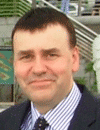08:00 | Registration |
|
Session: Hardware |
| |
09:15 |  | Conference Chair Laboratory Automation, Where to Next?
Malcolm Crook, Director, Peak Analysis & Automation Ltd, United Kingdom
Robotic technology is changing and progressing, this presentation will look at how the changes in technology could effect Laboratory Automation in the future. |
|
10:00 | The Automation of Formulation and Process Mapping for the Next Generation of Novel Products
Jamie Marsay, Project Manager, Labman Automation Ltd, United Kingdom
The implementation of automated formulation and process mapping using real-time feedback of process conditions in the 100g to 1kg range. An insight into real-time measurement and feedback of process parameters to optimise formulation times. Overview of simultaneous mixing, temperature control, formulation assessment, sensing and gravimetric additions of powders, liquids, gels and waxes. |
10:30 | Coffee & Networking in Foyer |
11:00 | Merging Lab Automation with Microfluidics Technology
Holger Becker, Chief Scientific Officer, Microfluidic ChipShop, Germany
The presentation will indicate trends and advantages of merging laboratory automation and microfluidics technology in order to perform complex protocols e.g. in diagnostics or biotechnology. |
11:30 | Practicalities of Automating Human Interaction with Robotic Cells
Barry Weller, Product Manager, Mitsubushi Electric Automation Systems UK, United Kingdom
A look at the use of industrial robots in work cell where operators need to load and unload products from the robots working area, what safety preclusions and solutions are available. |
12:00 | Can Nature Really Influence the Direction of Future Automation?
Andreas Schuele, MedLab Business Manager, Festo, Germany
Bionics provides new approaches to product development. Applied science, which derives findings from nature and transfers this knowledge to technology, is a field for the future. This will make automated movement patterns even more efficient and productive. |
12:30 | Lunch and Networking in Foyer |
13:15 |  Poster Session in Foyer Poster Session in Foyer
|
14:00 | High Performance Enclosures – The Best Way to Keep your Samples Fit for Use
Mark Beviss, Technical Sales Manager, Contained Air Solutions, United Kingdom
Contained Air Solutions explain the various methods by which safe containment of biological samples generated through automated processes can be achieved by the use of large microbiological safety cabinets fully compliant to the European Safety Standard EN12469:2000. |
|
Session: Software |
| |
14:30 | Back to the Future: Laboratory Automation User Interfaces
Rob Harkness, Business Development Manager, Peak Analysis & Automation Ltd, United Kingdom
There has been a trend in recent years to provide simpler software user interfaces for laboratory automated platforms. This talk will look at these interfaces, how they have evolved and what they may look like in the future. |
15:00 | Coffee & Networking in Exhibition Hall |
15:30 | SiLA—Standards to Improve Overall Lab Efficiency
Niklaus Graber, President , SiLA, Switzerland
SiLA, Standardization in Lab Automation, improves the efficiency of entire labs by delivering free and open standards for device interfaces and data formats. |
16:00 | LIMS Configuration - The Essential Ingredient for Successful Implementations
John Boother, Managing Director, Autoscribe Ltd., United Kingdom
The presentation will cover the importance of genuine configuration that enables a delivered LIMS to meet customer requirements without custom coding. |
|
Session: Science |
| |
16:30 | Biobanking and Biorepositories
Rivka Ravid, Brain Bank Consultant, Royal Dutch Academy of Sciences, Netherlands
The search for biomarkers and new proteins involved in neurological brain disorders has recently led to a better understanding of the pathobiology of these disorders. Study of the human hippocampus requires comprehensive knowledge of the genome, epigenome, transcriptome, proteome, and post-translational modifications (PTMs) of proteins. High-throughput sequencing techniques that are collectively called next generation sequencing (NGS) enable the analysis of gene expression profiles in cells and tissues, allowing powerful integration of expression data from the gene level to the protein level and "-omic" level assessment of PTMs. In this presentation we will focus on the proteomics of the human hippocampus, collected and preserved by brain banks and Biobanks, the techniques and protocols applied; with special emphasis on the integrated analysis of genomics, epigenomics, transcriptomics, and proteomics. |
17:00 | End of Day 1 |



